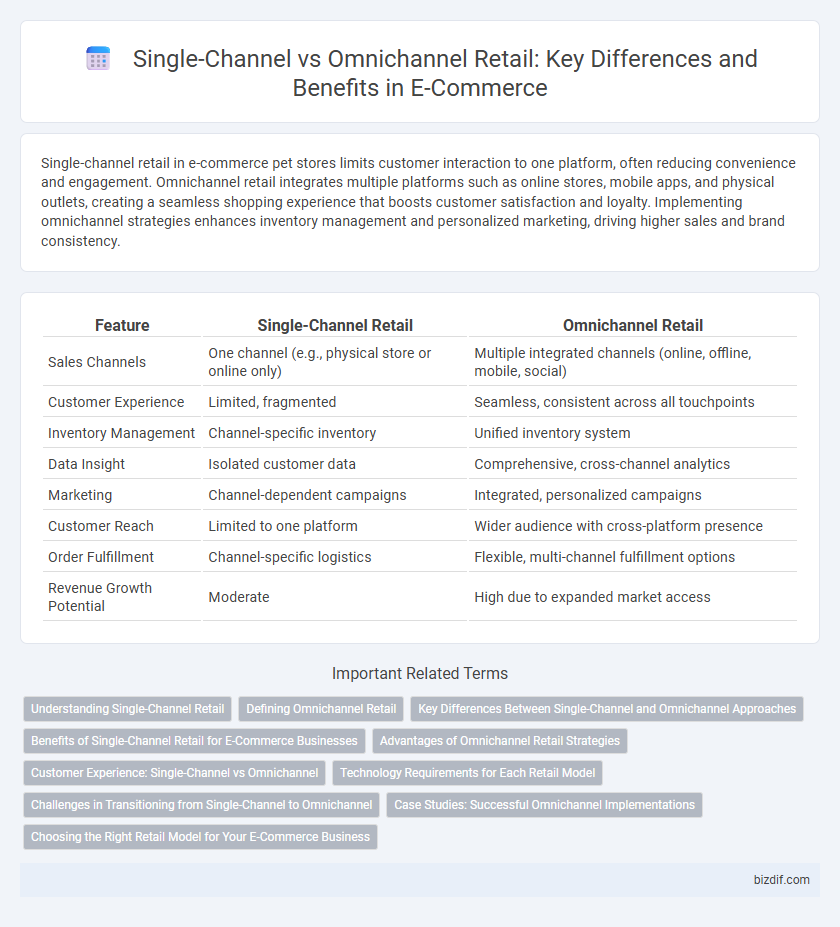Single-channel retail in e-commerce pet stores limits customer interaction to one platform, often reducing convenience and engagement. Omnichannel retail integrates multiple platforms such as online stores, mobile apps, and physical outlets, creating a seamless shopping experience that boosts customer satisfaction and loyalty. Implementing omnichannel strategies enhances inventory management and personalized marketing, driving higher sales and brand consistency.
Table of Comparison
| Feature | Single-Channel Retail | Omnichannel Retail |
|---|---|---|
| Sales Channels | One channel (e.g., physical store or online only) | Multiple integrated channels (online, offline, mobile, social) |
| Customer Experience | Limited, fragmented | Seamless, consistent across all touchpoints |
| Inventory Management | Channel-specific inventory | Unified inventory system |
| Data Insight | Isolated customer data | Comprehensive, cross-channel analytics |
| Marketing | Channel-dependent campaigns | Integrated, personalized campaigns |
| Customer Reach | Limited to one platform | Wider audience with cross-platform presence |
| Order Fulfillment | Channel-specific logistics | Flexible, multi-channel fulfillment options |
| Revenue Growth Potential | Moderate | High due to expanded market access |
Understanding Single-Channel Retail
Single-channel retail operates through one primary sales platform, such as a physical store or a dedicated e-commerce website, limiting customer interactions to that single point of contact. This approach simplifies inventory management and marketing strategies but restricts reach and customer engagement compared to omnichannel retail. Understanding single-channel retail is essential for businesses determining resource allocation and growth potential in the competitive e-commerce landscape.
Defining Omnichannel Retail
Omnichannel retail integrates multiple sales channels--such as physical stores, online platforms, and mobile apps--into a seamless, unified customer experience. It leverages data synchronization and advanced CRM systems to provide personalized interactions and consistent branding across touchpoints. This approach enhances customer engagement and increases conversion rates compared to single-channel retail, which operates through only one sales avenue.
Key Differences Between Single-Channel and Omnichannel Approaches
Single-channel retail focuses on selling products through one primary platform, limiting customer interaction to a singular touchpoint such as a physical store or an online website. Omnichannel retail integrates multiple channels including physical stores, e-commerce websites, mobile apps, and social media, creating a seamless and consistent shopping experience across all platforms. The key differences lie in customer engagement, data integration, and purchasing flexibility, with omnichannel approaches offering enhanced personalization and unified inventory management to drive higher customer satisfaction and loyalty.
Benefits of Single-Channel Retail for E-Commerce Businesses
Single-channel retail in e-commerce streamlines operations by focusing on a single sales platform, reducing complexity and operational costs. This approach enables businesses to deliver a highly tailored customer experience, optimizing product listings and marketing strategies specifically for one channel. Narrowing focus enhances inventory management and customer service efficiency, providing a strong foundation for startups or niche markets.
Advantages of Omnichannel Retail Strategies
Omnichannel retail strategies enhance customer experience by providing seamless integration across multiple platforms, including in-store, online, and mobile channels, leading to higher customer satisfaction and loyalty rates. This approach increases sales opportunities through personalized marketing and real-time inventory management, enabling businesses to meet customer demand efficiently. Data-driven insights from omnichannel systems optimize decision-making and streamline operations, resulting in improved profitability and competitive advantage in the e-commerce landscape.
Customer Experience: Single-Channel vs Omnichannel
Single-channel retail limits customer interaction to one platform, often restricting convenience and personalized service, which can lead to lower customer satisfaction. Omnichannel retail integrates multiple touchpoints such as online stores, mobile apps, and physical shops, providing a seamless and consistent customer experience. Studies show omnichannel customers have a 30% higher lifetime value due to improved engagement and tailored shopping journeys.
Technology Requirements for Each Retail Model
Single-channel retail systems typically require basic technology infrastructure such as a point-of-sale (POS) system and a simple e-commerce platform, focusing on one sales channel. Omnichannel retail demands advanced integration technology, including unified commerce platforms, real-time inventory management, customer relationship management (CRM) systems, and seamless synchronization across various sales channels like online, mobile, and physical stores. Investing in APIs, data analytics, and cloud-based solutions enables omnichannel retailers to provide consistent customer experiences while optimizing operational efficiency.
Challenges in Transitioning from Single-Channel to Omnichannel
Transitioning from single-channel to omnichannel retail presents significant challenges including integrating disparate sales platforms, aligning inventory management across channels, and maintaining consistent customer experiences. Retailers must invest in robust IT infrastructure and data analytics to unify customer data and enable real-time inventory visibility. Overcoming organizational silos and training staff to manage multichannel operations are critical steps for successful omnichannel implementation.
Case Studies: Successful Omnichannel Implementations
Case studies reveal that omnichannel retail strategies significantly boost customer engagement and sales by integrating online, mobile, and physical store experiences. Brands like Nike and Sephora demonstrate successful omnichannel implementations through personalized marketing, seamless inventory management, and unified customer service platforms. These approaches increase customer retention and average order value compared to traditional single-channel retail models.
Choosing the Right Retail Model for Your E-Commerce Business
Choosing the right retail model for your e-commerce business depends on your target audience and operational capacity. Single-channel retail focuses on one sales platform, simplifying inventory management but limiting customer reach, while omnichannel retail integrates multiple sales channels, enhancing customer experience and increasing conversion rates through seamless interactions. Businesses with scalable infrastructure and diverse customer bases benefit more from omnichannel strategies to boost engagement and sales growth.
Single-Channel Retail vs Omnichannel Retail Infographic

 bizdif.com
bizdif.com